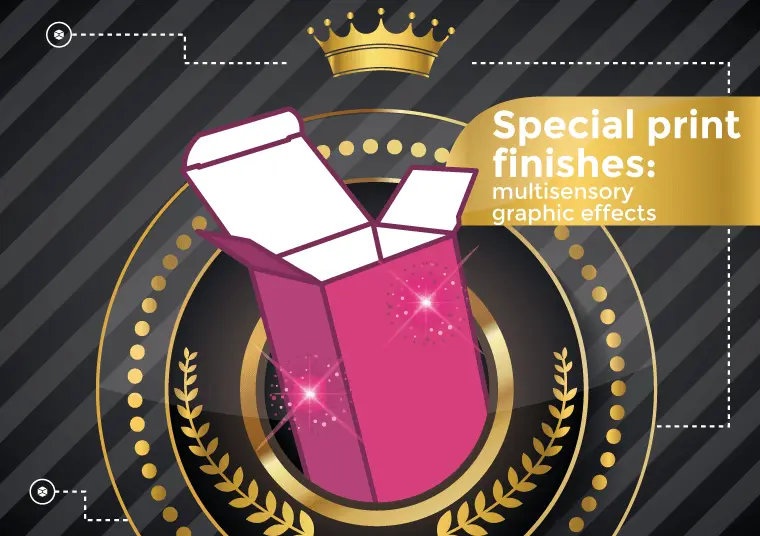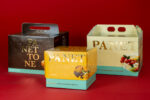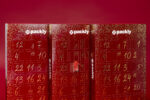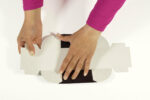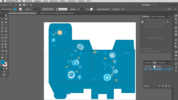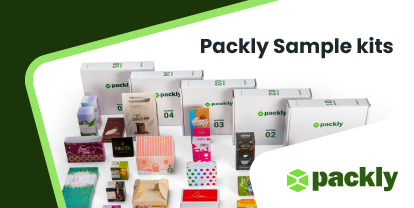In the article about “Printing techniques in the packaging world” we talked about the most popular print technologies in folding paper industry. Today, I want to tell you about some multisensory graphic effects, that you can obtain through these techniques. These special print finishes are used to add more value to the final product through embellishments. Their purpose is giving an added value to the artwork and involving the audience by using the product multisensory effects.
If you touch your customers, in fact, you will encourage them to purchase your product.
In this blog post I’ll try to talk about the most known and common special print finishes techniques, without overlooking any of them hopefully. Otherwise, remember that you can always comment on our posts with your suggestions, helping us fix them 🙂
The first thing to say is that in the last years special print finishes techniques, once performed only through traditional printing technologies, have been widely known thanks to the evolution of digital printing. The development of this kinds of technologies allowed the exceptional customization and embellishment of products even for short series, at a good price.
The results achievable through that processes are really different and interesting. Here below you can find a short list of the most used multisensory graphic effects and of the printing techniques to obtain them.
Metal effect
This kind of finishing is obtainable through the application on paper of proper metallic foils that will be transferred only to the selected areas. Through different printing technologies the metallic material will be added.
In the traditional hot stamping, the foil will be inserted between cliché and sheet. While printing, the cliché will be heated and, once pressed on the support, due to the heat the foil layer will be transferred on sheet. Digital hot stamping does not provide foil transfer through cliché, but uses heated toners and specific foils.
In the last years, a cold process has been developed, known as cold foil. In this case, the foil will hold on sheet through a specific glue, that can be transferred on the support through flexography.
Based on the foil chosen, it is possible to obtain different kinds of finishes, not only brilliant and metallic (eg. gold and silver), but also with a texture, glossy, matt, and so on.
Glossy and opaque coating
This kind of effect can be realised both on specific areas (spot) and on the entire printing surface (full board). Spot effects are obtainable by applying on the preferred areas special transparent inks or varnishes. Application with no reserve, then full background, can be obtained through lamination or varnishing of the whole surface.
The lamination consists in a gloss or matte plastic coating applied to the printing paper surface. In the hot lamination the plastic material is melted and then applied to the support using specific rollers, while cold lamination requires the use of special adhesives.
Varnishing consists in applying specific varnishes on the printing support, and it can be applied through flexography or serigraphy. Packly applies a water-based varnish on packaging to protect the print, that’s why the final result tends to be glossy.
It is very usual a combined use of glossy and opaque varnishes (eg. drip off) that will give life to very interesting and appealing graphic results, able to catch the attention of observers on specific areas of the artwork.
Relief and bas-relief
Relief illustrations, texts and symbols are used to give “added touch value” to a printing sheet.
There are two different effects: embossing, when material is raised against the background, and debossing, when sunken into surface of the material.
To create the impression, the paper is pressed between an embossing die and debossing die (cliché and counter clichè); using processes like thick screen printing or through high thickness varnishing (Digital Embossing).
Soft- touch
As the word suggests, artworks embellished with soft-touch have a soft effect while touching them. Soft-touch can be obtained through lamination or using special inks able to create this touch sensation.
Conclusions
The above-mentioned effects are the most known and used. Cleverly choosing the kind of embellishment to apply on your artwork is really important to catch the attention of the observers and effectively communicate your own message.
The various effects, in fact, are often able to refer more or less directly the features of a product and convey its visual and touch sensations giving more to the experience of consumers. Through some inks and scented papers is possible, in addition, to recreate perfumes and smells in order to amplify the sensory stimulation of users.
Embellishments, obviously, are an optional choice and that’s not all. At the base of any work a valid message and a good project able to convey it are needed.
Currently, these special print finishes are not available on Packly…but just for now 🙂
